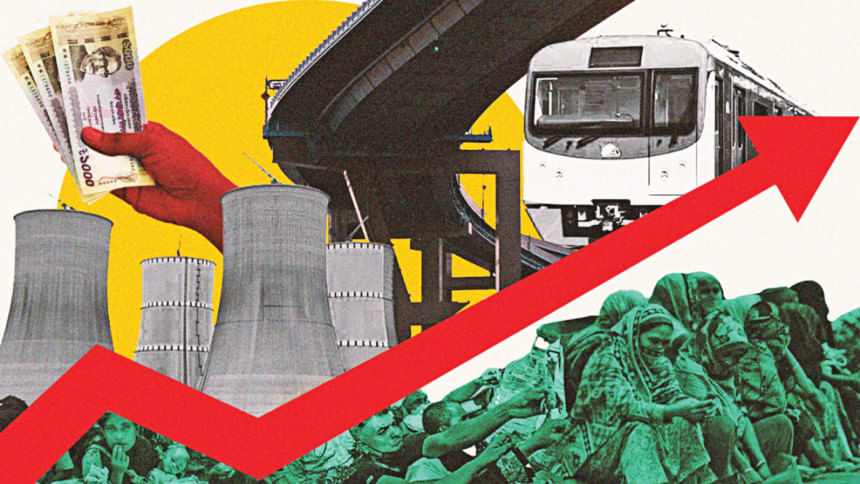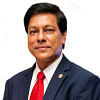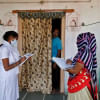Bangladesh's rising population: A demographic dividend won’t pay off on its own

Bangladesh's population has reached 17.57 crore, according to the United Nations Population Fund (UNFPA), making it the eighth most populous country in the world. With an annual growth rate of around 1.22 percent, approximately 21 lakh people are being added each year. While some see this huge population as a potential economic strength, others view it as a growing burden. To put it differently, is Bangladesh's rising population a challenge or an opportunity for sustainable development? To answer this, we need to examine key aspects of the nation's demographic and socio-economic realities.
Turning the population into an asset requires a strong focus on improving education and skill development to create a more capable and innovative workforce. It also demands greater investment in healthcare, human development, and policies that promote economic opportunities and social inclusion. Unfortunately, in our so-called "role model" approach to development, education and healthcare—two of the most vital pillars for building human resources—have been largely neglected. Bangladesh spends only around two percent of its GDP on education, the lowest among South Asian countries. As a result, nearly 40 percent of adults in Bangladesh remain illiterate, according to the Bangladesh Bureau of Statistics' Literacy Assessment Survey 2023. The survey shows that 60.77 percent of people aged 15 and above are considered literate, with literacy rates of 62.84 percent for males and 58.24 percent for females.
Although Bangladesh has recorded steady GDP growth of over six percent annually over the past decade, this economic growth has not created enough decent, well-paying jobs for its growing young population. Official data shows that more than seven crore people are currently employed in the country, but about 85 percent of them are engaged in the informal sector—working as rickshaw-pullers, street vendors, day labourers, or in farming, transport, and construction. Such jobs lack job security, fair wages, and social protection. Presently, around 27.4 lakh people are officially unemployed, with the unemployment rate estimated at 4.63 percent. However, experts believe the real figure is considerably higher. The data also reveals that nearly 68 lakh people are underemployed or underutilised, including more than 13 lakh graduates who remain unable to find suitable employment matching their qualifications. This growing mismatch between education and job opportunities remains a major challenge for sustainable development.
The link between population health and economic progress is well established. Without a healthy population, a healthy economy is impossible. Currently, the country invests only 0.7 percent of GDP and two percent of the national budget in health. In the 2024 Global Hunger Index (GHI), Bangladesh ranked 84th out of 127 countries. The GHI measures hunger and malnutrition using four key indicators: undernourishment, child wasting, child stunting, and child mortality. According to the report, around 12 percent of Bangladesh's population is undernourished, 23.6 percent of children under five are stunted, 11 percent are underweight, and 2.9 percent die before reaching their fifth birthday. Bangladesh is also falling behind in ensuring proper nutrition for infants and young children, with high rates of micronutrient deficiencies, especially vitamin A, iron, iodine, and zinc. A UNICEF report titled "Child Food Poverty: Nutrition Deprivation in Early Childhood" shows that two in every three children under five in Bangladesh suffer from child food poverty.
Rapid population growth is also reducing the availability of capital per person and limiting access to essential services such as food, water, housing, sanitation, healthcare, education, and employment. This, in turn, fuels poverty, inequality, crime, and environmental damage. Bangladesh is already one of the most densely populated countries in the world, with nearly 1,300 people living per square kilometre. This intense demographic pressure is straining its natural resources, including forests, rivers, and agricultural land. Each year, the country loses a significant amount of farmland, driven not only by population growth but also by rapid industrialisation, unplanned urbanisation, and rural settlement. According to the Soil Resource Development Institute (SRDI), nearly 69,000 hectares of farmland are disappearing annually, threatening future food security.
The environmental consequences of this are far-reaching. Several studies have shown that growing population, coupled with poor governance and flawed urban planning, is accelerating the degradation of rivers, wetlands, and forests. A recent report by the National River Conservation Commission revealed that of the 770 rivers that once flowed across the country, only 405 remain, with over 100 having vanished since independence. Many housing projects, both government and private, have been built on wetlands. As a result, wetland areas have been shrinking, particularly in and around Dhaka. This has led to serious environmental problems.
According to a report by this daily, since 2010, Dhaka has lost approximately 43,200 acres of wetlands out of a total of 187,958 acres. This means that around 22 percent of the city's wetlands have vanished in just over a decade. Deforestation has also reached alarming levels, with an estimated 246,000 hectares of forest lost between 2001 and 2023, according to Global Forest Watch.
To end on a slightly positive note, Bangladesh's growing population presents both a challenge and an opportunity. At present, around two-thirds of the population—nearly 11.5 crore people—are of working age, between 15 and 64 years. Some policymakers describe this large working-age population as a "demographic dividend." However, the term is often misunderstood, with many assuming its benefits will come automatically. That is far from reality. Unlocking the true potential of this demographic advantage depends entirely on strategic investments in education, skills development, healthcare, and decent job creation. Without these critical measures, the growing number of unemployed and underemployed youth will only fuel social frustration, inequality, and unrest. The sooner we recognise this and take effective action, the greater the chances of transforming our population burden into an opportunity—not only for economic growth but also for social stability and environmental sustainability. The future depends on the choices we make today.
Abu Afsarul Haider is an entrepreneur. He can be reached at [email protected].
Views expressed in this article are the author's own.
Follow The Daily Star Opinion on Facebook for the latest opinions, commentaries and analyses by experts and professionals. To contribute your article or letter to The Daily Star Opinion, see our guidelines for submission.

 For all latest news, follow The Daily Star's Google News channel.
For all latest news, follow The Daily Star's Google News channel. 










Comments